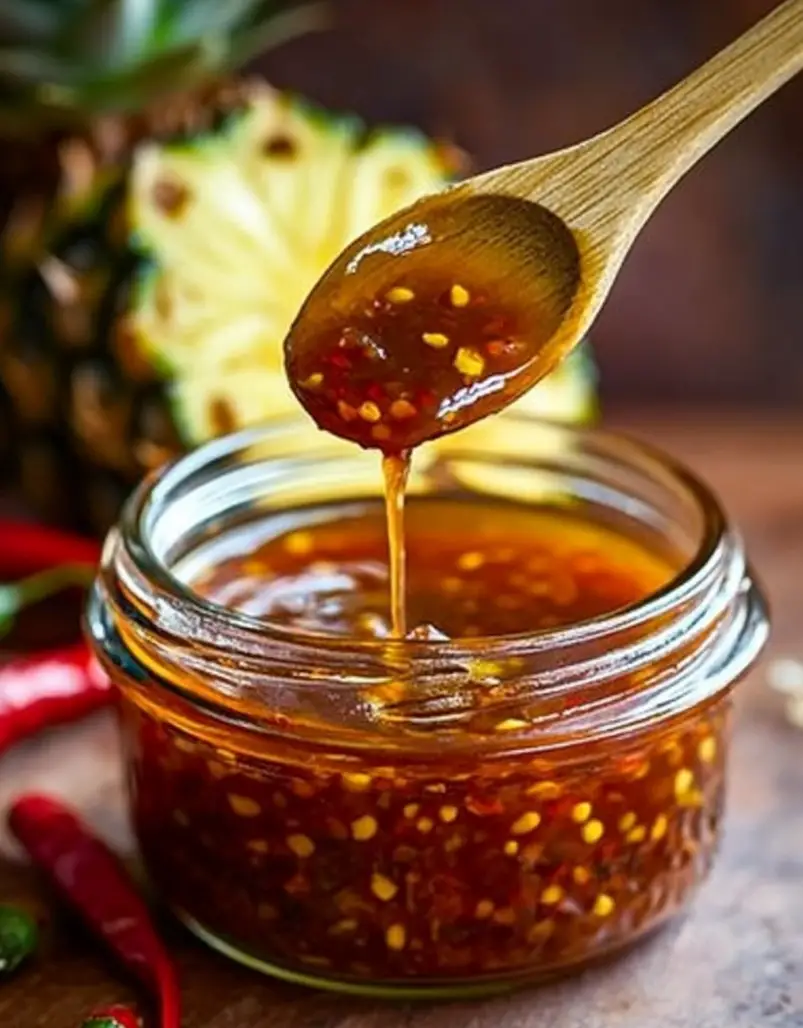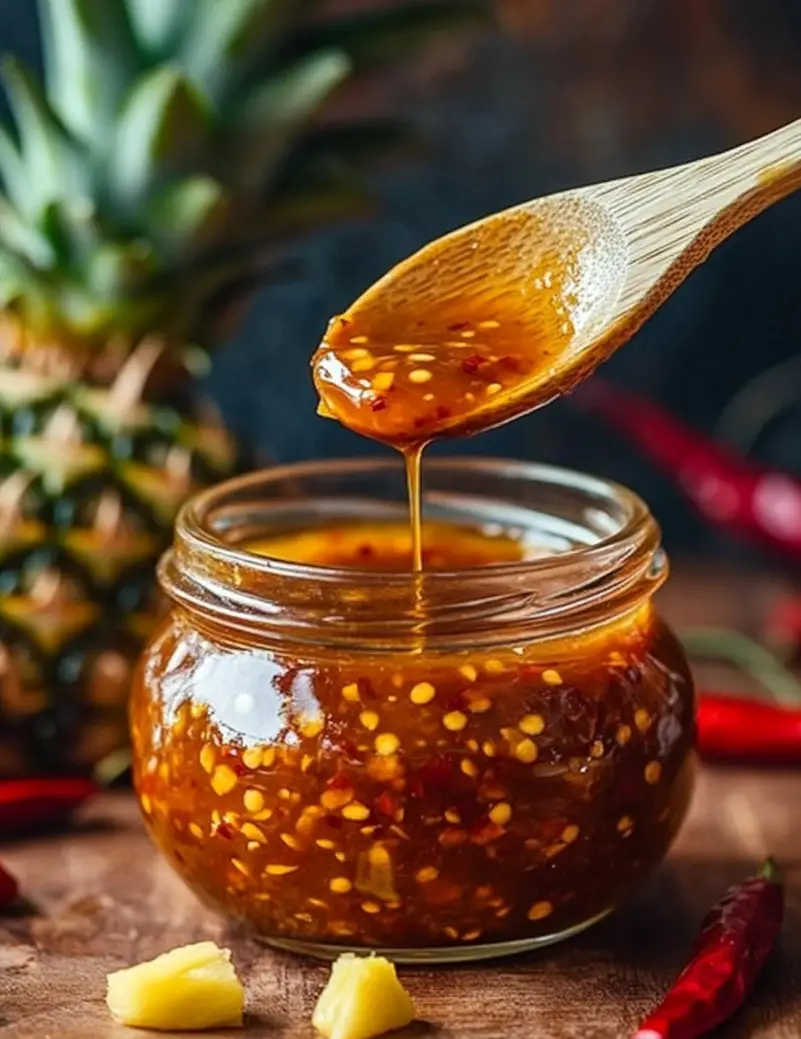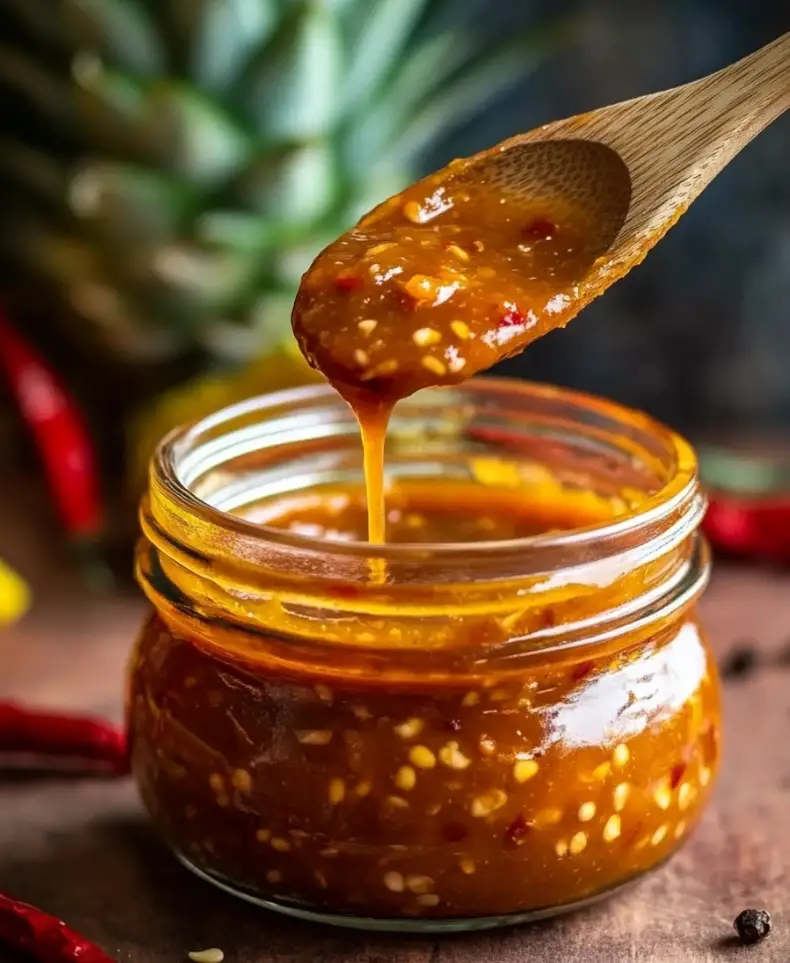Introduction to Chili Pineapple Sauce
What Makes This Sauce Special?
Chili Pineapple Sauce offers a remarkable balance of sweet and spicy, making it a standout condiment for grilled meats, seafood, or even vegetable dishes. This sauce is perfect for elevating a barbecue or adding a touch of flair to weeknight meals. The pineapple juice contributes a bright, tropical sweetness, while the chili flakes introduce just the right amount of heat. A combination of rice vinegar and soy sauce balances the flavors with a hint of acidity and umami. Whether used as a marinade, glaze, or dipping sauce, it’s highly versatile and easy to prepare.
Beyond its immediate culinary appeal, this recipe stands out for its simplicity. With just a few common pantry ingredients and a short cooking time, it’s accessible for both beginners and experienced home cooks. Plus, it offers the flexibility to adjust spice levels, sweetness, and consistency based on personal preference.

Basic Recipe for Chili Pineapple Sauce
Ingredients Needed
- 1.5 cups white sugar
- 1 cup pineapple juice
- 1/2 cup rice vinegar
- 1/4 cup soy sauce
- 2 cloves garlic, minced
- 1-2 teaspoons chili flakes (to taste)
- 1 teaspoon cornstarch (for thickening)
- 2 tablespoons water (for cornstarch mixture)
Step-by-Step Instructions
1. Combine Ingredients in a Saucepan:
Place a medium saucepan over medium heat. Add the sugar, pineapple juice, rice vinegar, soy sauce, garlic, and chili flakes. Stir the ingredients continuously until the sugar is fully dissolved.
2. Bring to a Simmer:
Let the mixture reach a gentle simmer, allowing the flavors to meld together. Simmering the sauce helps enhance the balance of sweet, salty, and spicy flavors while releasing the aroma of pineapple and chili.
3. Prepare the Cornstarch Slurry:
In a small bowl, mix the cornstarch with 2 tablespoons of water to form a smooth slurry. This will act as a thickening agent to give the sauce the right consistency.
4. Thicken the Sauce:
Gradually pour the slurry into the simmering sauce while stirring continuously. Keep stirring to ensure the sauce thickens evenly without any lumps forming.
5. Adjust Consistency and Flavor:
Simmer the sauce for another 5-10 minutes, allowing it to thicken to your desired consistency. Taste the sauce and adjust the heat by adding more chili flakes, or balance the sweetness by adding a splash of vinegar.
6. Cool and Store:
Once the sauce has reached your preferred consistency, remove it from the heat and let it cool. The sauce can be served warm or at room temperature, depending on your dish.
Advanced Techniques for Enhanced Flavor
How to Make the Most of Your Chili Pineapple Sauce
1. Use Fresh Ingredients for a Bolder Flavor:
If you want a more pronounced tropical taste, use freshly squeezed pineapple juice instead of bottled. Similarly, freshly minced garlic will provide a stronger aroma than pre-minced garlic.
2. Customize the Heat Level:
While chili flakes provide an easy way to add heat, you can swap them for other chili varieties, such as sriracha for a smoother spice or habanero for an intense kick.
3. Infuse with Aromatics:
Add a teaspoon of freshly grated ginger or lemongrass to create a more complex flavor profile. These ingredients pair well with the pineapple base and complement the chili’s heat.
4. Introduce a Smoky Element:
To give the sauce a smoky touch, stir in a small amount of smoked paprika or liquid smoke. This is especially effective if you plan to use the sauce with grilled meats.
5. Play with Citrus Accents:
Consider adding lime or orange zest for a citrusy punch that adds complexity to the sweetness. These accents help brighten the overall flavor, making the sauce feel lighter.

Maintenance Tips: Storing and Reheating Chili Pineapple Sauce
How to Store the Sauce for Maximum Freshness
- Refrigeration: Store the sauce in a glass jar or airtight container in the refrigerator for up to two weeks. The acidity from the vinegar helps preserve the sauce’s freshness.
- Freezing for Long-Term Storage: If you want to store the sauce for longer periods, freeze it in small batches using ice cube trays. Transfer the frozen cubes to a freezer-safe bag for easy portioning.
- Preventing Crystallization: If the sugar starts to crystallize in the refrigerator, reheat the sauce gently over low heat while stirring continuously to dissolve the sugar again.
Reheating Tips
- Reheat the sauce slowly over low heat, stirring occasionally to prevent burning or sticking.
- If the sauce becomes too thick after refrigeration, add a small amount of water or pineapple juice while reheating to restore its original consistency.
Dietary Adaptations and Substitutions
Making the Sauce Fit Different Dietary Needs
1. Gluten-Free Option:
Substitute the soy sauce with tamari or coconut aminos to make the sauce gluten-free. Both options provide the umami flavor without gluten, ensuring everyone can enjoy the dish.
2. Low-Sugar Version:
Replace half the sugar with natural sweeteners like honey or maple syrup. These substitutions add depth to the flavor, though they might alter the sauce’s thickness slightly.
3. Vegan-Friendly Adjustments:
This recipe is naturally vegan, but if using store-bought soy sauce, double-check the label to ensure it aligns with vegan standards, as some brands use fish-based additives.
4. Low-Sodium Variation:
Reduce the sodium content by opting for low-sodium soy sauce. You can also experiment with seasoning alternatives like seaweed powder to maintain the umami taste without added salt.
5. Spiciness Control for Sensitive Palates:
If you’re making the sauce for someone sensitive to heat, reduce the chili flakes or omit them entirely. A dash of paprika can be used instead to add subtle warmth without overwhelming spiciness.

Frequently Asked Questions (FAQs)
1. Can This Sauce Be Used as a Marinade?
Yes! The combination of sweet and savory flavors makes this sauce an excellent marinade for meats like chicken, pork, or fish. For best results, marinate the protein for at least 2 hours or overnight to infuse the flavors fully.
2. How Do I Prevent the Sauce from Burning?
Keep the heat at medium or lower while simmering, and stir frequently to prevent the sauce from burning or sticking to the bottom of the pan. If the sauce starts to thicken too quickly, add a splash of water to loosen it.
3. Can I Make a Sugar-Free Version?
Yes, you can use sugar alternatives such as monk fruit sweetener or stevia. Keep in mind that these alternatives might slightly alter the sauce’s taste and consistency.
4. What Are the Best Pairings for This Sauce?
Chili Pineapple Sauce pairs beautifully with grilled chicken skewers, pork chops, shrimp, and stir-fried vegetables. It also makes a fantastic dip for spring rolls and dumplings.
5. How Long Does the Sauce Last in the Refrigerator?
Stored properly in an airtight container, the sauce will last up to two weeks in the refrigerator. Make sure to stir it well before serving if it has been sitting for a few days.
